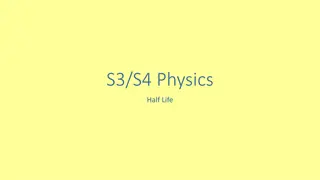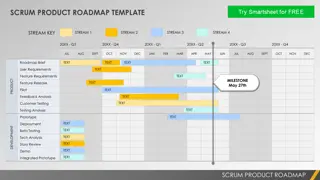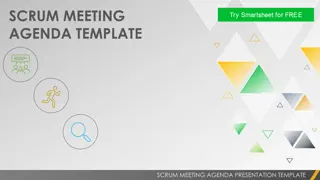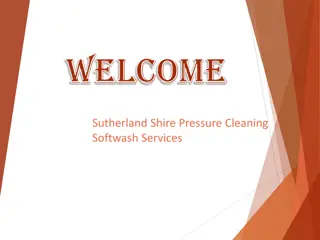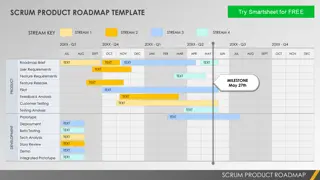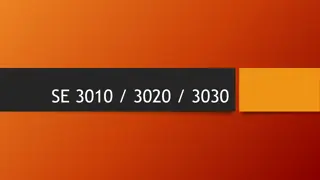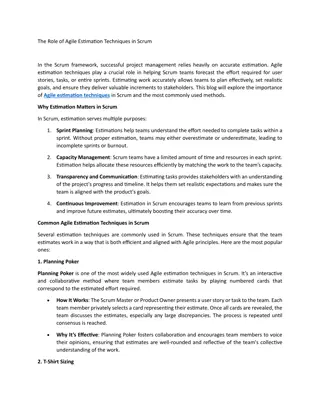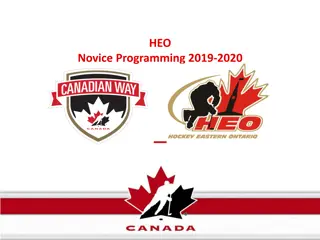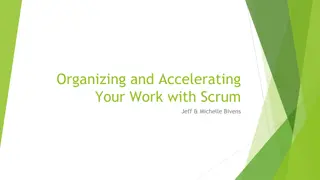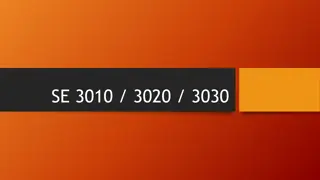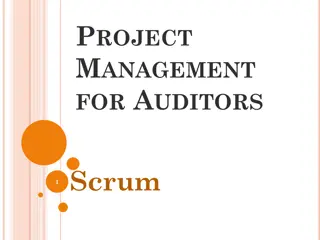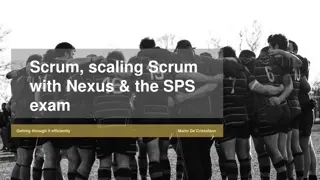Scrum: The Art of Doing Twice the Work in Half the Time by Jeff Sutherland
Scrum is a powerful methodology that aims to boost productivity by streamlining project management processes. The book delves into the essence of Scrum, offering insights on how to achieve more in less time. It also discusses the challenges faced by organizations, like the FBI, in managing institutional knowledge and modernizing systems. With examples of failed programs and the importance of adaptability, the content emphasizes the need for continuous improvement in project execution.
Download Presentation

Please find below an Image/Link to download the presentation.
The content on the website is provided AS IS for your information and personal use only. It may not be sold, licensed, or shared on other websites without obtaining consent from the author.If you encounter any issues during the download, it is possible that the publisher has removed the file from their server.
You are allowed to download the files provided on this website for personal or commercial use, subject to the condition that they are used lawfully. All files are the property of their respective owners.
The content on the website is provided AS IS for your information and personal use only. It may not be sold, licensed, or shared on other websites without obtaining consent from the author.
E N D
Presentation Transcript
Scrum The Art of Doing Twice the Work in Half the Time Jeff Sutherland Co-creator of Scrum http://covers.audiobooks.com/images/covers/full/9780804165822.jpg
Virtual Case File 9/11 The FBI lacked the ability to know what it knew: there was no effective mechanism for capturing or sharing its institutional knowledge. Al Qaeda activists entering the country in the weeks and months before 9/11 One office was suspicious of one person Another wondered why so many suspicious foreigners were getting flight training. Another had someone on a watch list but never told anyone. No one in the Bureau ever put it all together
Virtual Case File When senators started asking uncomfortable questions, the FBI responded with their plan to modernize VCF Cost: $70 million on top of the $100 million already budgeted. Three years later the program was cancelled. IBM and Microsoft 2005 FBI announced a new program: SENTINEL Lockheed Martin: $451 million, to be operational in 2009 Every change required a contract negotiation 2010. $405 million spent, halfway done and a year late Estimated 6 to 8 years to completion and an additional $350 million
Waterfall Gantt Chart Discover Design Project Start Business Requirements Develop Technical Design Test Coding & Testing Client OK & Launch Months in the making Charts that showed everything that needed to be accomplished and the time it would take Every single step in a project is laid out every milestone, every delivery date they are always, always wrong. once the beautifully elegant plan meets reality, it falls apart.
Fixing the FBI Restarted with the development brought in house Months spent unraveling contracts and cutting staff to under 50 Printed all the requirements documents (inches thick) 1,100 requirements documented Reviewed and prioritized 80 / 20 rule focused on the 20 Core team was smaller (12) Go-live completion commitment 12 months with cost of $20 million (amount remaining in the Sentinel budget) Fall 2011
A simple idea Whenever you start a project Why not check in, see if what you are doing is heading in the right direction? if it s actually what people want and question whether there are any ways to improve how you re doing what you re doing, any ways of doing it better and faster and what might be keeping you from doing that. Inspect and Adapt
Impediment removal Management s responsibility Flow Production should flow swiftly and calmly throughout the process management task is to identify and remove impediments to that flow Taichi Ohno s The Toyota Production System Senior management needs to understand in their bones that impediments are nearly criminal.
Sentinel Using the Inspect and Adapt cycle, the team took roughly three months to figure out how long completing the project would really take. Sequential goals were set each required to be completed in a fixed length of time. The team used two week cycles Sprints At the end of each Spring cycle, an increment of product was finished Finished means these was something working that could be shown to anyone who cared stakeholders (optimally, the people that would be using that increment of product)
Real-time feedback Is the team headed in the right direction? Demos. Driving toward a demonstrable product on a frequent basis Is what they are planning to do next really what they should be doing given the experience and work during the just completed cycle? At the beginning of each new Spring cycle The team decides how much can be accomplished in the next two weeks Work items are selected from the prioritized list of things that need to be done The team decides how many of these items can get done in the next Sprint cycle
SCRUM is not about developers Scrum is about customers and stakeholders. For the Sentinel project Showing the actual product was the most powerful part Jeff Johnson Skepticism infected the FBI The guys down in the basement are just going to screw it up again just one more temporary system that will fail, and we ll have to go back to using paper. July of 2012 Sentinel was turned on success!
The Sentinel team Still working in the basement a room without windows Panels removed from their cubicles so they can see each other A room without windows Poster-size copy of Agile principles on the wall Still making improvements and adding functionality to the system they built
Old joke in the Scrum community Chicken and pig are walking down the road The chicken says, Hey, pig, I was thinking we should open up a restaurant. What should we call it? asks the pig. How about Ham and Eggs ? No thanks, says the pig. I d be committed, but you d only be involved! The pigs are the ones committed to the project and responsible for the outcome. The chickens are those informed of its progress, the stakeholders.
Takeaways Planning is Useful. Blindly following plans is stupid. All the work needed on a large project laid out with detailed plans when detailed plans meet reality, they fall apart. Fail fast so you can fix early. Corporate culture puts more weight on forms, procedures, and meetings than on visible value creation that can be inspected at short intervals by users. Work that does not create real value is madness.
Inspect and Adapt W. Edwards Deming Worked for General Douglas MacArthur during the occupation after WW II. His influence on Japanese manufacturing was dramatic Trained engineers in statistical process control Measure exactly what is being done How well and strive for continuous improvement Constantly creating experiments to see if you can achieve improvement PDCA cycle (Plan, Do, Check, Act) to act means to change your way of working based on real results and real environmental input. Waterfall Method insists that everything can be planned ahead of time, and wouldn t change over the course of a multiyear project.
Teams Teams are what get things done in the world of work. Businesses all too often focus solely on individuals (performance bonuses, promotions, hiring ) A big mistake You want the best people, and people are different, so focus on getting the best performers Yale study Correlation between student time spent on a project and the grade? None. Fastest students outpaced slowest by ratio of 10:1 Conclusion: Hire A students that earn the A in the shortest amount of time. But
IBM study Looked at team performance data on 3,800 projects If the best team could perform a task in one weak assuming members were A students expect a 10:1 ratio in comparing best and not-best teams. What was the ratio? It did not take the slow team 10 weeks to do what the best team could do in a week It took 2,000 weeks 2,000 :1
Characteristics of Best Teams 1. Transcendent The team s sense of purpose is beyond the ordinary. The decision to not be average, but to be great, changes the way they view themselves, and what they re capable of. 2. Autonomous The teams are self-organizing and self managing, they have the power to make their own decisions about how they do their jobs, and are empowered to make those decisions stick. 3. Cross-Functional The teams have all eh skills needed to complete the project planning, design, production, sales, distribution.
Key Concepts in Scrum Autonomy Team members decide themselves how they re going to do the work. It s management s responsibility to set the strategic goals, but it s the team s job to decide how to reach those goals.
Key Concepts in Scrum Cross-Functional Team member of the project that designed a revolutionary new camera for Canon: When all the team members are located in one large room, someone s information becomes yours, without even trying. You start thinking in terms of what s best or second best for the group at large and not only where you stand.
Key Concepts in Scrum Teams have all the skill necessary to get things done. soup to nuts No separation of roles. Team diversity skill set, thinking and experience Teams that can get a whole project done. Teams that are unselfish and autonomous Teams decide how to do the work. A characteristics of Best Teams test: When a specialist identifies with their specialty more than with the product they re actually making Best will not happen
Size does matter Data shows that team s velocity slows down with more than 9.
Data A large team can take about five times the number of hours that a small team would. Study: 491 medium-size-projects at hundreds of different companies. Project requiring new products or features As teams grew larger than 8, they took dramatically more time. Teams of 3 to 7 required 25% of the effort of teams of 9 to 20
Scrum team Needed characteristics: 1. Intense focus on the goal 2. Radical collaboration 3. Hunger to crush anything in their way 4. Universal excitement when any team member broke through with the ball
Scrum Master Responsible for ensuring process is effective Someone between a team captain and a coach Facilitator Make sure there is transparency Help the team discover what is getting in the way Guide the team towards continual improvement Continually asking: How can we do what we do better. What can we change about how we work? What is our biggest sticking point?
Fundamental Attribution Error A test. When you are blaming someone, you are finding fault with them personally. When you are being blamed, you are more aware of the situational factors that led to the problem and why you did what you did. We all see ourselves as responding to a situation, while we see others as motivated by their character. Deming s point: It s the system that surround us, rather than any intrinsic quality, that accounts for the vast majority of our behavior.
The lesson we are all creatures of the system we find ourselves embedded in. Scrum instead of seeking someone to blame, try to examine the system that produced the failure and fix it. Blame is Stupid Don t look for bad people; look for bad systems ones that incentivize bad behavior and reward poor performance.
The Sprint MIT Media Lab projects policy Every 3 weeks each team had to demo to their colleagues what it was working on. An open demo anyone could come If the demo was not both working and cool , the directors killed the project. Sprints Work for a short period of time and stop and see where you are.
Backlog Doing Done Sticky notes (or whiteboard) Board is divided into three columns Backlog (work that needs to done) Doing (team member undertakes one of the tasks, moving it from Backlog to Doing) Done (when is finished) Criteria: when it can be used by the customer
Daily Stand-up Scrum master is in charge Asks each member: 1. What did you do yesterday to help the team finish the Sprint? 2. What will you do today to help the team finish the Spring? 3. What obstacles are getting in the team s way? That s it! 15 minutes max! No assigning of tasks from above the team is autonomous
1990s Borland Quattro Pro for Windows Team met every day to discuss One hour Self-organized around challenges SCRUM Rules: 1. Meeting held at the same time every day, everyone had to be there 2. Meeting could not last more that fifteen minutes 3. Everyone had to actively participate Passivity is not only lazy, it actively hurts the rest of the team s performance.
Sutherlands speech to teams large and small Do you really want to suck forever? Is that what your motivation is in life? Because it s your choice, you know you don t have to be that way. A team has to demand greatness from itself!
Waste is a Crime Three different types of waste: 1. Waste through unreasonableness 2. Waste through inconsistency 3. Waste through outcomes Deming s PDCA cycle Plan means avoid unreasonableness Do means avoid inconsistency Check means avoid inconsistency Act means the will, motivation and determination to do all that.
One thing at a time Multitasking the research Those who drive while talking on cell phones even hands free get into more accidents than people who don t Quote: even when participants direct their gaze at objects in the driving environment, they often fail to see them when they are talking on a cell phone because attention has been directed away from the external environment and toward an internal, cognitive context associated with the phone conversation. it appears that the people who are most likely to multi- task and most apt to use a cell phone while driving are those with the most inflated views of their abilities.
Multitasking Researchers conclusions: People don t multitask because they are good at it. They have trouble inhibiting the impulse to do another activity. People who multitask the most just can t focus. They can t help themselves. Sutherland We all do it. It s hard not to. The key thing to remember is that it s stupid.
Loss to context switching Quality Software Management, Gerald Weinberg Number of Simultaneous Projects 1 2 3 4 5 Percent of Time Available per Project 100% 40% 20% 10% 5% Loss to Context Switching 0% 20% 40% 60% 75%
Half Done Isnt Done at All Work in Progress Expended effort, but have not created any value. Doing half of something is, essentially, doing nothing. SCRUM rhythm to the work Each iteration ends with stuff done Done means complete. A tangible deliverable, ready to be shown to a customer Done means fully tested no hand-off to others with their own plans.
Work fewer hours slacking? Scott Maxwell (founder of OpenView Venture Partners) Shifted to SCRUM and looked at comparisons: Working more hours produced stopped producing more output Peak productively falls at a little bit less than 40 hours a week.
What about waste? Unreasonableness.. working more hours Give teams challenging goals, but not requiring them to strive for absurd, impossible goals. Unreasonable expectations requiring heroic efforts to meet deadlines kills continuous improvement. Unreasonable overburdening the team the behavior documented in Dilbert cartoons. Ureasonable behavior waste that is generated when a company has an asshole in its midst.
The goal Effortless flow No wasted movement nothing extraneous no longer an effort. Emotional waste is a distraction






